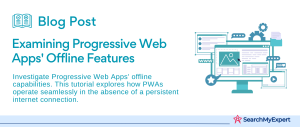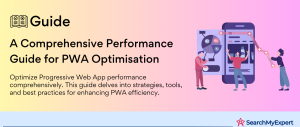Cross-Browser Compatibility for Progressive Web Apps
Unlocking the Full Potential of Progressive Web Apps
In the dynamic digital landscape, Progressive Web Apps (PWAs) emerge as a game-changer, seamlessly blending the capabilities of native apps with the broad accessibility of web applications. At their core, PWAs leverage modern web technologies to deliver an app-like experience directly within a web browser. This innovative approach offers several key benefits:
- Enhanced Performance:
PWAs are designed to be fast and efficient, significantly reducing load times and improving user engagement. - Offline Functionality: With service workers, PWAs can function offline or on low-quality networks, providing uninterrupted access.
- Platform Independence: They are not bound to specific platforms, allowing them to run across various devices and operating systems.
- No Installation Required: PWAs bypass app store downloads, enabling direct access from a web browser.
- Automatic Updates: Users always experience the latest version without the need for manual updates.
The Criticality of Cross-Browser Compatibility
For PWAs to truly realize their potential, cross-browser compatibility is paramount. This compatibility ensures that PWAs deliver a consistent and optimal user experience across all web browsers, including Chrome, Firefox, Safari, and Edge. The universal accessibility of PWAs hinges on their ability to function flawlessly regardless of the browser choice, thus reaching a wider audience and ensuring inclusivity in the digital realm.
Navigating the Challenges
Achieving perfect cross-browser compatibility is not without its challenges. Variances in browser engines, differences in CSS and JavaScript support, and the diverse range of devices and screen sizes create a complex web of factors that developers must skillfully navigate. This complexity underscores the importance of robust testing and adaptive design strategies to ensure that PWAs maintain their functionality and appeal across the diverse spectrum of web browsers.
Key Features Impacting Browser Compatibility
Navigating the Waters of Cross-Browser Compatibility in Progressive Web Apps
In the realm of Progressive Web Apps (PWAs), certain features play a pivotal role in shaping cross-browser compatibility. Understanding these features is crucial for developers and businesses alike, as they navigate the choppy waters of browser variances. Let’s dive into the core features that significantly impact browser compatibility.
Service Workers: The Backbone of Offline Functionality
Service Workers are essentially scripts that run in the background, separate from the web page, enabling key functionalities like offline support and background sync. They act as proxy servers, allowing PWAs to control network requests and cache resources.
- Offline Functionality:
Service Workers empower PWAs to load and function effectively even without an internet connection, enhancing user experience. - Background Operations: They facilitate background syncs and updates, ensuring the app is always current.
- Compatibility Concerns:
Despite their advantages, Service Workers can present compatibility issues. Variations in support and implementation across browsers like IE and older versions of others can be challenging.
Push Notifications: Engaging Users Across Platforms
Push Notifications are vital for keeping users engaged and informed. They enable PWAs to send timely, personalized updates directly to users’ devices.
- User Engagement: They boost interaction and re-engagement with users, even when the PWA is not actively being used.
- Browser Variations:
The way Push Notifications are implemented and handled can vary significantly across browsers, impacting delivery and user experience.
Web App Manifest: The Visual Identity of PWAs
The Web App Manifest is a JSON file that controls how the PWA appears to the user and dictates its launch parameters. It’s pivotal for the ‘add to home screen’ feature, influencing app installation and visual branding.
- App Installation and Branding:
It allows customization of the app’s appearance on the user’s device, reinforcing brand identity. - Browser Handling Differences: Different browsers may interpret and implement the Web App Manifest differently, affecting the app’s appearance and behavior.
App Shell Model: Ensuring Smooth Offline Browsing
The App Shell Model is an architectural approach that involves pre-caching the core elements of the UI. This model ensures that the PWA’s shell loads fast, even on slow networks or offline.
- Offline Experience: It provides a reliable and instant offline experience by loading the basic UI at first, followed by dynamic content.
- Older Browser Challenges: Compatibility with older browsers can be an issue, as they might not fully support the technologies underpinning the App Shell Model.
Testing for Cross-Browser Compatibility
Mastering the Art of PWA Testing Across Browsers
Testing for cross-browser compatibility is an indispensable step in the Progressive Web App (PWA) development process. It ensures that a PWA functions uniformly and efficiently across different browsers, devices, and operating systems. Let’s delve into the methods and tools crucial for this task.
Automated vs. Manual Testing: A Balanced Approach
- Automated Testing: This method uses software tools to run tests automatically, checking for various aspects like functionality, performance, and compatibility. Automated testing is efficient for repetitive tasks and helps in quickly identifying issues.
- Manual Testing: In contrast, manual testing involves human testers interacting with the app in various browsers. It’s essential for evaluating user experience aspects that automated tests might miss.
A balanced approach, combining both automated and manual testing methods, is often the most effective strategy.
Cross-Browser Testing Tools: The Tech Arsenal
Several tools and platforms have emerged as frontrunners in facilitating cross-browser testing for PWAs:
- Selenium:
A powerful tool for automated web testing, widely used for its flexibility and broad browser support. - BrowserStack:
Offers real device testing in the cloud, enabling testing across a multitude of browser and OS combinations. - LambdaTest: Provides an online platform for both automated and manual cross-browser testing.
- CrossBrowserTesting: Allows testing on various browsers and devices, ensuring comprehensive coverage.
These tools help simulate different environments, providing an accurate picture of how a PWA performs across the spectrum of user scenarios.
The Importance of Diverse Device and OS Testing
Testing a PWA on a variety of devices and operating systems is crucial. This diversity ensures that the PWA delivers a consistent and high-quality user experience, irrespective of the user’s choice of device or operating system. From smartphones to tablets, and Windows to macOS, each combination can present unique challenges and opportunities for optimization.
Strategies for Improving Compatibility
Optimizing Progressive Web Apps Across Diverse Browsers
The journey of a Progressive Web App (PWA) from development to deployment is fraught with the challenge of ensuring compatibility across various browsers. Employing strategic approaches is key to overcoming this challenge. Let’s explore some of these vital strategies.
Feature Detection and Polyfills: Crafting a Flexible PWA
- Adapting to Browser Capabilities: Feature detection involves identifying if a browser supports certain features, and then tailoring the PWA’s functionality accordingly. This approach avoids errors and enhances user experience.
- Using Polyfills:
Polyfills are scripts that add missing features to browsers. They act as a bridge, allowing developers to use modern web features while maintaining compatibility with older browsers.
Graceful Degradation: Ensuring Basic Functionality
- The Concept:
Graceful degradation is the strategy of building the PWA with advanced features, but ensuring that it still provides a basic level of functionality in browsers that don’t support these
features. - User Experience: This approach prioritizes user experience, ensuring that all users, irrespective of their browser’s capabilities, can access the core content and functionality of the PWA.
Progressive Enhancement: Elevating User Experience
- Building Up from a Solid Base:
Progressive enhancement is the process of starting with a basic level of user experience and progressively adding enhancements for browsers with advanced capabilities. - Enriching for Modern Browsers: This strategy focuses on providing an improved, more engaging experience for users on modern browsers, while still maintaining accessibility and functionality for users on older browsers.
Browser-Specific Compatibility Considerations
Tailoring Progressive Web Apps for Every Browser
Each web browser has its unique quirks and features, presenting specific challenges and considerations for Progressive Web App (PWA) compatibility. Let’s dive into the nuances of some of the most popular browsers: Chrome, Safari, Firefox, and Edge, and explore best practices for optimizing PWAs for each.
Google Chrome: The Trailblazer
- Challenges:
Chrome often leads with new features, which may not be supported in other browsers initially. - Best Practices: Regularly update PWAs to leverage the latest Chrome features while ensuring fallbacks for other browsers.
- Resources: Chrome’s PWA documentation provides comprehensive guidelines and updates.
Safari: The Unique Player
- Challenges:
Safari’s strict privacy settings, like Intelligent Tracking Prevention, can impact PWA functionalities like caching. - Best Practices:
Test PWAs rigorously on Safari, especially for features like Service Workers and Web App Manifest. - Resources: Apple offers detailed Safari PWA support information that is crucial for developers.
Mozilla Firefox: The Open-Source Advocate
- Challenges: Firefox’s rapid release cycles can introduce new features or deprecate old ones quickly.
- Best Practices:
Stay informed about Firefox updates and test PWAs accordingly. - Resources:
Mozilla’s developer network provides extensive PWA-related insights.
Microsoft Edge: The New Contender
- Challenges:
Since its shift to the Chromium engine, Edge has become more compatible but still has unique traits. - Best Practices:
Leverage Chromium’s features while keeping an eye on the Edge-specific behaviors. - Resources:
Microsoft’s Edge documentation offers valuable guidance for PWA development.
Tools and Resources for Developers
Empowering Developers in Crafting Cross-Compatible PWAs
Building and testing Progressive Web Apps (PWAs) that are cross-browser compatible requires a robust set of tools and resources. From libraries and frameworks to developer communities, these resources play a crucial role in facilitating the development of effective and efficient PWAs. Let’s explore some essential tools and resources available to developers.
Libraries and Frameworks
- Workbox: A set of libraries that simplify PWA development, particularly for caching strategies and offline functionality. Workbox
- React PWA Library:
For developers using React, this library offers an easy way to create PWAs. React PWA - Angular Service Worker: Angular provides built-in service workers making it easier to turn applications into PWAs. Angular PWA
Testing Tools
- Lighthouse: An open-source, automated tool for improving the quality of web pages, including PWAs. Lighthouse
- Puppeteer:
A Node library for controlling headless Chrome or Chromium, useful for automated testing. Puppeteer
Developer Communities and Forums
- Stack Overflow: A vital resource for troubleshooting and community support. Stack Overflow PWA Tag
- PWA Slack Community:
An active Slack group where developers can discuss PWA development. PWA Slack
Documentation and Best Practices
- Mozilla Developer Network (MDN):
Offers comprehensive documentation on web standards and best practices. MDN Web Docs - Google Developers:
Provides extensive resources and case studies on PWA development. Google Developers
Utilizing these tools and resources can significantly streamline the process of developing and testing PWAs, ensuring they perform optimally across various browsers and devices.
Embracing Cross-Browser Compatibility: The Keystone of PWA Success
As we explore cross-browser compatibility for Progressive Web Apps (PWAs), it’s clear that this compatibility is not just a feature — it’s a cornerstone. Ensuring that PWAs work seamlessly across various browsers is crucial for reaching and engaging a wider audience.
Recap of the Importance
- Universal Access:
Cross-browser compatibility ensures that users, regardless of their browser preference, have access to the full functionality of the PWA. - Enhanced User Experience:
A consistent and smooth experience across different browsers leads to higher user satisfaction. - Broader Reach: Compatibility widens the potential user base, tapping into diverse segments of the market.
Final Tips for Developers
- Stay Informed:
Keep up-to-date with the latest browser updates and standards. - Test Rigorously: Regularly test your PWA across different browsers and devices.
- Engage with the Community:
Utilize developer communities for support, feedback, and new ideas. - Prioritize Accessibility: Make your PWA accessible to as many users as possible by focusing on compatibility.
Conclusion
Prioritizing cross-browser compatibility in PWAs is not just a technical consideration; it’s a commitment to inclusivity and excellence in the digital landscape. By adhering to best practices, utilizing the right tools, and staying attuned to the evolving web environment, developers can create PWAs that truly stand the test of time and technology.
Build seamless, engaging web experiences with Progressive Web App Service Companies.
Further Reading
Table of Contents
Toggle






